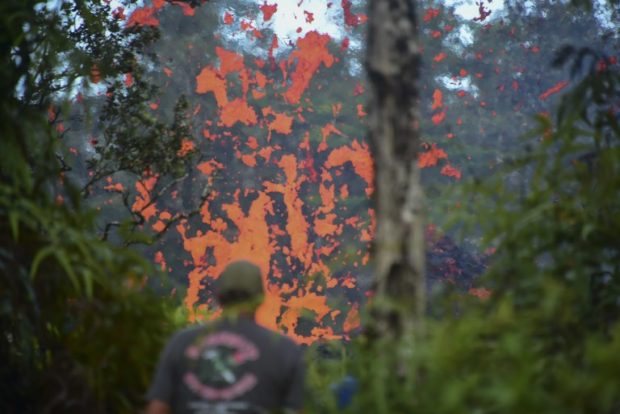Geologists: Explosive event possible at Hawaii volcano

A man watches as lava is seen coming from a fissure in Leilani Estates subdivision on Hawaii’s Big Island on May 4, 2018. Up to 10,000 people have been asked to leave their homes on Hawaii’s Big Island following the eruption of the Kilauea volcano that came after a series of recent earthquakes. / (AFP PHOTO / FREDERIC J. BROWN)
PAHOA, Hawaii — Geologists warned on Wednesday that Hawaii’s Kilauea volcano could erupt explosively and send boulders, rocks, and ash into the air around its summit in the coming weeks.
The United States Geological Survey (USGS) said the risk will rise if the lava drops below the groundwater level beneath the summit’s caldera.
An influx of water inside could cause steam-driven explosions. There was also the potential for ash, steam, and sulfur dioxide emissions.
Kilauea is one of the world’s most active volcanoes.
Article continues after this advertisementIt has destroyed 36 structures since it began releasing lava into fissures that opened in a Big Island residential neighborhood last week.
Article continues after this advertisementSince the eruptions began, 14 such fissures have opened in a subdivision and destroyed dozens of structures, including 26 homes.
In the weeks ahead, the volcano could eject blocks up to two yards (meters) in diameter a little less than a mile (a kilometer) away, the USGS said.
It may also send pebbles shooting into the air several miles (kilometers) away, the USGS added.
In the Leilani Estates subdivision, police went door-to-door on Tuesday to roust residents near two new volcanic vents emitting dangerous gases in areas where lava has poured into streets and backyards.
Authorities previously ordered nearly 2,000 residents to leave the two communities in the mostly rural district of Puna on Hawaii’s Big Island last Thursday. But some ignored the order and stayed to watch over their property.
The emergence of the two new vents prompted Hawaii County to issue a cellphone alert ordering stragglers in the Lanipuna Gardens neighborhood to get out immediately. Police followed up with personal visits.
Officers found a number of people still at their residences but there was no sign of holdouts later, said Talmadge Magno, administrator for Hawaii County Civil Defense.
Edwin Montoya, 76, had planned to stay to care for animals and keep looters away from his family’s property in Leilani Estates. He was forced to evacuate after the new fissures emerged, including one just a mile (1.6 kilometers) away.
“I’m in my truck right now on my way up the road,” he said. “The police came down here and made me.”
Both communities are in a forested, remote part of the Big Island on the eastern flank of Kilauea volcano, which has been erupting continuously since 1983.
In recent years the volcano has mostly released lava in hard-to-reach areas inside a national park or along the coastline. But last week, vents popped open and released lava, gas, and steam inside neighborhoods.
There was no indication when the eruption might stop, or how far the lava might spread.
Andrew Nisbet has no idea what happened to his house since he left it.
“My home is right in the line of the major breakouts so maybe, maybe not,” he said on Monday during a community meeting.
Authorities urged Scott Wiggers to evacuate but he refused.
“I’m in the safest part of the subdivision. There’s no threat to my house whatsoever,” said Wiggers, a tour guide.
Wiggers said he was not leaving his home on the outskirts of the evacuation zone because he worried that if he did, he would not be able to get back in. But he was prepared in case the situation takes a turn.
“I am packed. My truck is loaded. I’m not a dumb-dumb. If I see a threat, I’m out of here,” he said.
Officials warned that lava could flow downhill and burn areas that do not currently face danger. They also stressed that toxic volcanic gas could kill people, especially the elderly and those with breathing problems.
Hawaii Gov. David Ige, a Democrat, told evacuees he has called the White House and the Federal Emergency Management Agency to tell officials that he believes the state will need help to deal with the volcano.
There are 14 lava-and-gas producing fissures in Leilani Estates. But the flow of lava is not constant. /kga